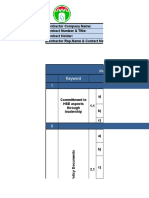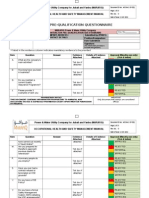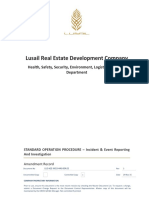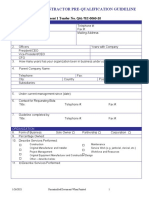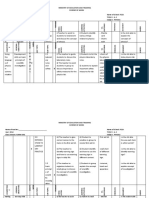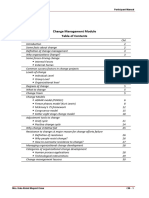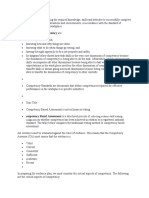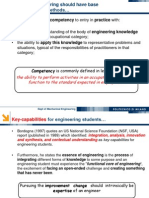Supplier Questionnaire - Supplier Form
Supplier Questionnaire - Supplier Form
Uploaded by
Syed TaherCopyright:
Available Formats
Supplier Questionnaire - Supplier Form
Supplier Questionnaire - Supplier Form
Uploaded by
Syed TaherOriginal Description:
Copyright
Available Formats
Share this document
Did you find this document useful?
Is this content inappropriate?
Copyright:
Available Formats
Supplier Questionnaire - Supplier Form
Supplier Questionnaire - Supplier Form
Uploaded by
Syed TaherCopyright:
Available Formats
Supplier / Contractor Pre-Award HSSE Questionnaire (Version 1 - 1 June 2011)
Supplier / Contractor
A.N. Other plc
Date of Assessment
Wednesday, September 01, 2010
Completed By
John Smith
Required KPIs are listed on the 2nd tab
HSSE stands for Health, Safety, Security & Environment
Please cover all aspects in your responses to the questions
Keyword
Question
Response
Document
Leadership & HSSE Culture
Committment to HSE
aspects through
leadership
1.1
a)
How are senior managers personally involved in HSE management for example objectivesetting and monitoring?
b)
c)
Provide evidence of commitment at all levels of the organisation?
a)
Does your company have an HSE policy document?
If the answer is YES please attach a copy.
b)
Who has overall and final responsibility for HSE in your organisation?
c)
Who is the most senior person in the organisation responsible for this policy being carried out
at the premises and on site where his employees are working? Provide name and title.
d)
Itemise the methods by which you have drawn your policy statements to the
attention of all your employees?
e)
What are your arrangements for advising employees of changes in the policy?
a)
Does your company have strategic HSE objectives?
If the answer is YES please attach a copy.
b)
Itemise the methods by which you have communicated your strategic HSE objectives to the
attention of all your employees?
How do you promote a positive culture towards HSE matters?
HSSE Policy & Strategic Objectives
HSE contract strategic
objectives
HSE Policy Documents
HSE Objectives
2.2
Organisation, responsibilities, resources, standards and documentation
HSE standards
Contractor management process
Cometence assurance
General HSE training
HSE training of managers, supervisors and HSE critical
positions
Organisational structure for HSE management
2.1
HSSE Policy
a)
How is your organisation structured to manage and communicate HSE effectively?
b)
Do HSE meetings promote HSE awareness?
c)
Do client and contractor meet regularly to discuss and action any interface situations?
d)
What provision does your company make for HSE communication meetings?
Please provide an organisation chart
a)
Have the managers and supervisors at all levels who will plan, monitor, oversee and carry out
the work received formal HSE training in their responsibilities with respect to conducting work
to HSE requirements?
b)
If YES please give details. Where the training is given in-house please describe the content
and duration of courses. Please provide an example of training matrix.
c)
How have you identified areas of your companys operations where specialised training is
required, for instance training related to health hazard such as radiation, asbestos and
chemicals?
d)
What specialist HSE resources does your organisation have available?
e)
How does your company provide HSE specialised training for HSE staff?
a)
What arrangements does your company have to ensure new employees have knowledge of
basic industrial HSE, and to keep this knowledge up to date?
Details of content
b)
What arrangements does your company have to ensure new employees also have knowledge
of your HSE policies, practices and company requirements?
Details of content
c)
What arrangements does your company have to ensure new employees have been instructed
and have received information on any specific hazards arising out of the nature of the
activities?
Details of content
a)
Does your organisation have a competence system in place?
If YES, please describe the scope and content of your competence system.
b)
What arrangements does your company have to ensure existing staff HSE knowledge is up to
date?
a)
Does your company have a contractor management process or system?
If yes, provide an outline of the process.
b)
How do you assess contractors, HSE competence or HSE performance?
c)
Where do you define the company standards you require your contractors to meet?
d)
How do you ensure these standards are met and verified?
a)
How do you identify new industry or regulatory standards that may be applicable to your activities?
3.1
3.2
3.3
Organisation chart
Training matrix
3.4
3.5
3.6
Contractor management process outline
Supplier / Contractor Pre-Award HSSE Questionnaire (Version 1 - 1 June 2011)
Supplier / Contractor
A.N. Other plc
Date of Assessment
Wednesday, September 01, 2010
Completed By
John Smith
Required KPIs are listed on the 2nd tab
HSSE stands for Health, Safety, Security & Environment
Please cover all aspects in your responses to the questions
HSE standards
Keyword
Question
3.6
b)
Is there an overall structure for producing, updating and disseminating standards?
c)
Are your company standards aligned with OGP/industry guidelines or recommended
practices? If yes state which one.
a)
How does your company identify hazards, assess risk, control and mitigation
consequences, to a level as low as reasonably practicable?
a)
Do you have specific policies and programmes on specific health hazards e.g. substance
abuse, blood borne thogens, malaria pandemic diseases etc.
b)
What type of health hazards (chemical, vibration, noise, radiation, etc) are
associated with the scope of your services? Explain how occupational health
hazards are identified, assessed and controlled.
c)
What systems are in place to control these hazards and monitor the effectiveness of these
controls? Is workers regular exposure monitoring part of these systems?
a)
What type of safety hazards (mechanical guarding, work at height, lifting and hoisting,
confined space entry, explosive atmospheres etc.) are associated with the scope of your
services?
b)
What systems are in place to control these hazards and monitor the effectiveness of these
controls?
a)
What type of logistics hazards (land transport, air transport, marine transport, materials
handling etc.)are associated with the scope of your services?
b)
What systems are in place to control these hazards and monitor the effectiveness of these
controls?
a)
What type of environmental hazards (chemical spill, atmospheric emissions, waste disposal
etc.) are associated with the scope of your services?
b)
What systems are in place to control these hazards and monitor the effectiveness of these
controls?
a)
What type of security hazards (terrorism, hostage taking, robbery, hostile local population etc.)
are associated with the scope of your services?
b)
What systems are in place to control these hazards and monitor the effectiveness of these
controls?
a)
What type of social hazards are associated with the scope of your services?
b)
What systems are in place to control these hazards and impacts and monitor the effectiveness
of these controls?
Response
Document
Risk Management
4.1
Safety hazards
4.3
Logistics hazards
4.4
Environmental
hazards
4.5
Security hazards
4.2
4.6
Social responsibility
hazards
Health Hazards
Risk Assessment &
Control
4.7
Planning & Procedures
HSE operations
manual
5.1
a)
Do you have a company HSE-MS manual (or operations manual with integrated HSE
requirements) which describes in detail your company approved HSE working practices
relating to your work activities?
If the answer is YES please attach a copy of an index and relevant supporting documentation.
Infrastructure and
equipment integrity
5.2
a)
How do you ensure that infrastructure, plant and equipment used within your operations (own
premises, client site, or at other locations) are correctly certified, registered, controlled and
maintained in a safe working condition?
Management of
change
5.3
a)
How do you manage changes and assess associated risks e.g. personnel, equipment,
processes, documentation?
Emergency planning
and response
a)
What arrangements does your company have for emergency planning and response?
5.4
b)
Which emergency situations are included?
Implementation and performance monitoring
HSE-MS implementation and active performance monitoring of work
activities
a)
What arrangements does your organisation have for monitoring the implementation of your
HSE-MS?
b)
How does your company assure the implementation of work procedures within your work-site
operations e.g. compliance with procedures, toolbox talks, safety meetings, supervision, job
observations?
c)
How do you monitor employee HSE performance e.g. hazard identification systems, HSE
participation?
d)
What active HSE monitoring is performed (i.e. where no incident has occurred)?
e)
How do you report and correct deficiencies identified?
f)
How do you communicate the results of active performance monitoring to relevant personnel?
6.1
HSSE-MS manual index & supporting
information
Supplier / Contractor Pre-Award HSSE Questionnaire (Version 1 - 1 June 2011)
Supplier / Contractor
A.N. Other plc
Date of Assessment
Wednesday, September 01, 2010
Completed By
John Smith
Required KPIs are listed on the 2nd tab
HSSE stands for Health, Safety, Security & Environment
Please cover all aspects in your responses to the questions
Keyword
HSE incident and investigation follow-up
HSE performance monitoring
Safety performance
indicators
Statutory notifiable
incidents or non
compliance notices
6.2
6.3
6.4
6.5
a)
See separate spreadsheet called Contractor Assessment KPI Data
a)
How is health performance monitored and recorded?
b)
How is environmental performance monitored and recorded?
c)
How is security performance monitored and recorded?
d)
How and what near miss incidents are reported?
e)
How often is HSE performance reviewed? By whom?
f)
How is logistics performance monitored and reported?
g)
Do you record vehicle incidents?
a)
What types of HSE incident are investigated?
b)
What process is used to investigate HSE incidents?
c)
Who conducts HSE incident investigations?
d)
How are the findings of an incident investigation followed up to ensure effective prevention of
recurrence?
e)
How is incident learning communicated to all relevant personnel?
a)
Has your company suffered any statutory notifiable incidents in the last five years (safety,
occupational health and environmental)?
Answers with details including dates, country and location, summary of incident and follow-up
preventative measures taken.
Document
Details of statutory notifiable incidents
or non compliance notices
HSE auditing and management review of HSE-MS
Management review and follow-up
Audits
a)
Do you have a written procedure for HSE auditing?
If yes, please attach a copy.
b)
Who is involved in conducting HSE audits? How are audit team members selected to have
specific expertise and be independent from the activities being audited?
What are the qualifications required for auditors?
c)
How does your company schedule HSE audit and what scope of auditing is covered? e.g.
internal, regulatory compliance, supplier/contractor, HSE management system implementation.
d)
How does management follow up on audit findings and ensure effective close out of action items?
a)
Do you have a written procedure for management review of the HSE-MS?
If yes, please attach a copy
b)
How often are HSE-MS reviews conducted and who is involved in the process?
c)
How are identified actions and improvement efforts recorded and tracked to effective completion?
Audit procedure
7.1
7.2
Response
Question
Management review procedure for
HSE-MS
HSE management - additional features
Certification of your
HSE-MS
8.1
Please provide information on any certification which you have received from certification bodies
Membership of
associations
8.2
Describe the nature and extent of your companys participation in relevant industry, trade, and
governmental organisations
Additional features of
your HSE-MS
8.3
Does your organisation (globally, regionally or locally) have any HSE features or arrangements
not described elsewhere in your response to the questionnaire?
Company specific information
END
Supplier pre-qualification Questionnaire - HSSE Data
See Glossary of terms for definition of each item
EXPOSURE
Current
Year
Year -1
Current
Year
Year -1
Current
Year
Year -1
Total Manhours worked
Exposure - Driving (km)
Exposure - Site Work (hours)
SAFETY
Fatalities
FAT
Lost Time Incidents
LTI
Lost Workday Cases
LWC
Restricted Workday Cases
RWC
Medical Treatment Cases
MTC
First Aid Cases
Total Recordable Cases (sum FAT, LWC, MTC, or RWC)
TRC
Near Miss Incidents
Fatal Accident Rate (per 108 hours)
FAR
Lost Time Injury Frequency (per 10 hours)
LTIF
Total Recordable Case Frequency (per 106 hours)
TRCF
ENVIRONMENT
Loss of Primary Containment (recordable
LOPC
Year -2
Year -3
Year -4
Year -2
Year -3
Year -4
Year -2
Year -3
Year -4
You might also like
- HSE Pre-Qualification ChecklistDocument11 pagesHSE Pre-Qualification ChecklistSri Dharan75% (40)
- HSE Capability AssessmentDocument5 pagesHSE Capability Assessmentsjmpak79% (19)
- Appendix P - HSE Management PlanDocument39 pagesAppendix P - HSE Management PlanMohammed100% (4)
- RAA Matrix All WorkersDocument2 pagesRAA Matrix All WorkersLucy Regalado100% (1)
- HSE Statistics PDFDocument5 pagesHSE Statistics PDFRashid100% (1)
- Appendix B HSE Plan 2019Document1 pageAppendix B HSE Plan 2019aymenmoatazNo ratings yet
- Green Banding - Supplier QuestionnaireDocument4 pagesGreen Banding - Supplier QuestionnaireGia Minh Tieu Tu75% (4)
- 04 CBLM With Competency Assessment ToolsDocument67 pages04 CBLM With Competency Assessment ToolsJai ØsterdalNo ratings yet
- Seplat Safe System of Work Scheme: Seplat Petroleum Development CompanyDocument16 pagesSeplat Safe System of Work Scheme: Seplat Petroleum Development CompanySegun Rufai100% (6)
- HSEDocument5 pagesHSEBlow67% (3)
- Subcontractor HSSE Prequalification QuestionnaireDocument11 pagesSubcontractor HSSE Prequalification QuestionnaireAli Hadi0% (1)
- Seplat Contractor HSE Capability - Rev3.Docx 4Document11 pagesSeplat Contractor HSE Capability - Rev3.Docx 4Sunday Augustine ChibuzoNo ratings yet
- QHSE Annual Report SampleDocument12 pagesQHSE Annual Report SampleVignesh NayamozhiNo ratings yet
- Hse Capability Evaluation QuestinnaireDocument26 pagesHse Capability Evaluation QuestinnaireAgajan YusupowNo ratings yet
- HSE Training ReportDocument1 pageHSE Training ReportpjosesmNo ratings yet
- Hse Manager Job DescriptionDocument14 pagesHse Manager Job DescriptionAnsarMahmoodNo ratings yet
- Hsep-04 - Hse Objective, Target & ProgramDocument4 pagesHsep-04 - Hse Objective, Target & ProgramScha AffinNo ratings yet
- Prequalification For HSE KPIDocument81 pagesPrequalification For HSE KPIBabu100% (1)
- CHESM Questionnaire GuidanceooDocument15 pagesCHESM Questionnaire GuidanceooWale OyeludeNo ratings yet
- 5.2.21 AY HSE Communication ProcedureDocument6 pages5.2.21 AY HSE Communication ProcedureMohamed OmarNo ratings yet
- 05-Contractor EHS CriteriaDocument33 pages05-Contractor EHS CriteriaendiqagppNo ratings yet
- Health, Safety, Security, Environment, and Quality PolicyDocument1 pageHealth, Safety, Security, Environment, and Quality PolicyVăn PhúcNo ratings yet
- Hse ProceduresDocument22 pagesHse ProceduresBrain Dee Tech LtdNo ratings yet
- Hse PlanDocument44 pagesHse Planzaim100% (1)
- P O S T (Post) : Ositive Perational Afety Arget Score CardDocument2 pagesP O S T (Post) : Ositive Perational Afety Arget Score CardekoimampNo ratings yet
- 9form Ohsms Prequalification QuestionnaireDocument17 pages9form Ohsms Prequalification QuestionnairemedobasNo ratings yet
- 02-010 Substance Abuse PolicyDocument6 pages02-010 Substance Abuse PolicyJoachimNo ratings yet
- LUS-HSE-WG3-446-004.03 - Incident Reporting & InvestigationDocument13 pagesLUS-HSE-WG3-446-004.03 - Incident Reporting & InvestigationamalNo ratings yet
- QHSE Budget Template 2022 Jyz60xDocument4 pagesQHSE Budget Template 2022 Jyz60xAlmerindo DOS SANTOSNo ratings yet
- HSE Questionnaire - Dragon Oil. 2Document10 pagesHSE Questionnaire - Dragon Oil. 2saneemlaltp thachaparamban0% (1)
- Rev. Issued For General Use Reference No. HSE-PRO-04-F06 0.0 Serial No. 1 of 1Document1 pageRev. Issued For General Use Reference No. HSE-PRO-04-F06 0.0 Serial No. 1 of 1subhanmusadiqNo ratings yet
- HSSE Improvement PlanDocument2 pagesHSSE Improvement Plansubhadipmanna8No ratings yet
- HSE Monitoring Plan Appendix 2Document1 pageHSE Monitoring Plan Appendix 2Sherif MahmoudNo ratings yet
- Quality, Health, Safety & Environment Policy: VisionDocument1 pageQuality, Health, Safety & Environment Policy: VisionpjosesmNo ratings yet
- Months Tolmann Allied Services Company Limited Training Calendar 2020Document5 pagesMonths Tolmann Allied Services Company Limited Training Calendar 2020Ese FregeneNo ratings yet
- SAMPLE HSE PlanDocument20 pagesSAMPLE HSE Planpete chizNo ratings yet
- AFP - HSE OCP-07-HSE Plan C3100000277 - Rev.01Document57 pagesAFP - HSE OCP-07-HSE Plan C3100000277 - Rev.01Siva Shankar100% (1)
- 2021 HSEQ Goals, Objectives, KPI's & Implementation PlanDocument2 pages2021 HSEQ Goals, Objectives, KPI's & Implementation PlanCandiceNo ratings yet
- Dashboard Data: Safety Inspections Safety Walkthroughs Hazard HuntsDocument4 pagesDashboard Data: Safety Inspections Safety Walkthroughs Hazard HuntsTFattah0% (1)
- Health: Key Performance Indicator Month of JANUARYDocument1 pageHealth: Key Performance Indicator Month of JANUARYSaddem Hadfi100% (2)
- HSE Plan DraftDocument5 pagesHSE Plan DraftElang Ishvara Destrian PutraNo ratings yet
- Minutes of MeetingDocument4 pagesMinutes of Meetingsiti nur fatihah100% (1)
- Monthly Statistical Report #32 UP03, March, 2022Document4 pagesMonthly Statistical Report #32 UP03, March, 2022yasirali43100% (1)
- Coshh Assessment FormDocument4 pagesCoshh Assessment FormLsri MurthyNo ratings yet
- HSE KPI Data Collection Tool BriefingsDocument20 pagesHSE KPI Data Collection Tool Briefingstnsv222No ratings yet
- HSE ProcedureDocument27 pagesHSE ProcedureKannan LakshmananNo ratings yet
- 1.0 Purpose / Scope: 2.1 HSE ObjectiveDocument1 page1.0 Purpose / Scope: 2.1 HSE ObjectiveKhaldoon AlnashiNo ratings yet
- Attachment Q6 - HSE Plan 2019Document1 pageAttachment Q6 - HSE Plan 2019aymenmoataz100% (1)
- Short Service Employee ProgramDocument12 pagesShort Service Employee ProgramhxmohamedNo ratings yet
- Procedure For Hse Risk Assessment 2Document1 pageProcedure For Hse Risk Assessment 2Dinesh BadheNo ratings yet
- HSEQ Policy Statement - English PDFDocument1 pageHSEQ Policy Statement - English PDFTovo RafaralahyNo ratings yet
- HEO Monthly HSE Perfomance Report 24 FeDocument11 pagesHEO Monthly HSE Perfomance Report 24 Feabdulla kasim100% (1)
- Dashboard Data: Safety Inspections Safety Walkthroughs Hazard HuntsDocument4 pagesDashboard Data: Safety Inspections Safety Walkthroughs Hazard HuntsWilson Lozano SilvaNo ratings yet
- HSE Performance Monitoring and MeasurementDocument6 pagesHSE Performance Monitoring and Measurementpawan pandey100% (7)
- Safe Use of Chemicals: 1.0 PurposeDocument10 pagesSafe Use of Chemicals: 1.0 PurposeFuzail AyazNo ratings yet
- Co-X QHS SOP13 HSE Performance Monitoring and Measurement Rev 02Document6 pagesCo-X QHS SOP13 HSE Performance Monitoring and Measurement Rev 02Abdellatef HossamNo ratings yet
- Contractor HSE Management Pre-QualificationDocument7 pagesContractor HSE Management Pre-Qualificationebyjoy100% (1)
- Training Matrix ProcedureDocument5 pagesTraining Matrix ProcedureSérgio Couto100% (1)
- Annex 07 - ODS-QHSE-SP-04 - Training & Competency ProcedureDocument6 pagesAnnex 07 - ODS-QHSE-SP-04 - Training & Competency ProcedureFahmi AbdullahNo ratings yet
- Reward and Penalty Procedure On HSE ViolationDocument9 pagesReward and Penalty Procedure On HSE ViolationMohammed Amer PashaNo ratings yet
- Skills Requisite To Prosper and Thrive in The InsdustryDocument11 pagesSkills Requisite To Prosper and Thrive in The InsdustryMimi RoyNo ratings yet
- Graduate-Profile SampleDocument1 pageGraduate-Profile SampleLuis Alfonso Buitrago TorresNo ratings yet
- TR Bartending NC IIDocument77 pagesTR Bartending NC IIChristopher NarioNo ratings yet
- Physics - F1Document15 pagesPhysics - F1Nyomenda Jamhuri WilliamNo ratings yet
- Code of Good Governance For The Professions in The PhilippinesDocument2 pagesCode of Good Governance For The Professions in The Philippinesjanna mae patriarcaNo ratings yet
- Competency - Based Learning Materials: Sector: Tourism SectorDocument74 pagesCompetency - Based Learning Materials: Sector: Tourism SectorValcy MadzNo ratings yet
- Anu DeviDocument24 pagesAnu DeviDaman Deep Singh ArnejaNo ratings yet
- BUSETH - Ethical Issues in EntrepreneurshipDocument4 pagesBUSETH - Ethical Issues in EntrepreneurshipAngelicaHermoParasNo ratings yet
- TR Heavy Equipment ServicingDocument95 pagesTR Heavy Equipment ServicingJuliusOuanoNo ratings yet
- FEPI Code of Ethics and Conducts 170908 PDFDocument18 pagesFEPI Code of Ethics and Conducts 170908 PDFMiss Oana100% (1)
- Chapter 2Document33 pagesChapter 2Wang TingNo ratings yet
- Competency MappingDocument10 pagesCompetency Mappingshannbaby22No ratings yet
- Performance Review Plan TemplateDocument9 pagesPerformance Review Plan TemplateJANET D.PAGADDUNo ratings yet
- Sachin Summer Training Report NEWDocument77 pagesSachin Summer Training Report NEWkunal roxNo ratings yet
- Change Management Module Participant ManualDocument30 pagesChange Management Module Participant Manualhalaomar100% (1)
- Risk ScorecardDocument26 pagesRisk ScorecardJesus Salamanca100% (1)
- Naop Level 1 & Level 2 Qualifications in Occupational Testing and AssessmentDocument8 pagesNaop Level 1 & Level 2 Qualifications in Occupational Testing and AssessmentPrateek VarmaNo ratings yet
- SSC/ N 9001: Manage Your Work To Meet Requirement: Session OverviewDocument5 pagesSSC/ N 9001: Manage Your Work To Meet Requirement: Session OverviewDevendra SecretNo ratings yet
- Research Article: Effect of Training and Development On Employee Attitude: A Study On KarachiDocument5 pagesResearch Article: Effect of Training and Development On Employee Attitude: A Study On KarachiAbdullah AfzalNo ratings yet
- The Issue of Leadership Styles in The Military Org PDFDocument7 pagesThe Issue of Leadership Styles in The Military Org PDFjorj chirilaNo ratings yet
- MATH 5 Curriculum MapDocument9 pagesMATH 5 Curriculum MapReynan HorohoroNo ratings yet
- Tesdanotes 2Document10 pagesTesdanotes 2Derek Carlos G. LituañasNo ratings yet
- NM Scientific Laboratory Division Part 2 Blood and Breath Testing Under The New Mexico Implied Consent ActDocument24 pagesNM Scientific Laboratory Division Part 2 Blood and Breath Testing Under The New Mexico Implied Consent ActcoyotelawNo ratings yet
- PPR TableDocument109 pagesPPR Tableapi-363995387No ratings yet
- LO2 Prepare and Produce Pastry ProductsDocument4 pagesLO2 Prepare and Produce Pastry ProductsMary Jane Ocampo100% (3)
- HB 90.6-2000 The Legal Profession - Guide To ISO 9001-2000 The Legal Profession - Guide To ISO 9001-2000Document19 pagesHB 90.6-2000 The Legal Profession - Guide To ISO 9001-2000 The Legal Profession - Guide To ISO 9001-2000SAI Global - APACNo ratings yet
- Farley Simon Nobre, David Walker, Robert Harris Technological, Managerial and Organizational Core Competencies Dynamic Innovation and Sustainable Development PDFDocument732 pagesFarley Simon Nobre, David Walker, Robert Harris Technological, Managerial and Organizational Core Competencies Dynamic Innovation and Sustainable Development PDFJuan Camilo ZapataNo ratings yet
- An Introduction To Engineers Competencies - 2012Document23 pagesAn Introduction To Engineers Competencies - 2012sbrencuNo ratings yet
- HR Competency ModelDocument39 pagesHR Competency ModelAwais AhmadNo ratings yet


















